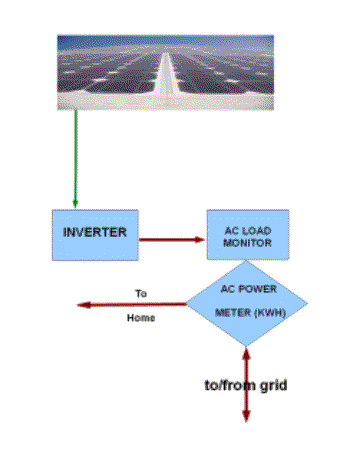|
Home Solar Power SystemsHome solar power systems draw the attention of homeowners, many homeowners seek background information on home solar power generation, on solar panels for home and on solar power inverters.
Home Solar Power Systems BackgroundAll home solar generators utilize the photovoltaic effect, the ability of certain materials such as Silicon to directly convert Sun radiation (light particles also known as photons) into Direct Current (stream of electrons). This fascinating technology has been developed in a relatively short time from a mere laboratory oddity, through solar electric panels that have powered space vehicles and satellites in the 1960s, into a multi billion industry in the first decade of the new millennium. The dwindling supply of crude oil coupled with the increased price of crude oil and the dramatic price reduction of photovoltaic panels made home solar systems a more attractive proposition. In fact, solar panels price dropped to $1 to $2 per watt in 2011/12.There is a grass root political drive to reduce the emission of CO2 (carbon dioxide) and to reduce fossil burning. This pressure from bellow is driving governments to grant energy tax credits or to guarantee a fair price to homeowners that sell back electrical power to the utility grid at feed in tariffs.
These incentives to homeowners installing solar power generators made the investment even more attractive. The advantages of home solar power systems are:
There are two types of home solar power systems. The first one is for homes that are connected to the grid. The production capacity of photovoltaic systems for grid-tied homes can be less than the home consumption because the electrical utility will supply the balance. A grid-connected home doesn’t need to store electrical energy from day to night, so storage batteries are not a must. If power shutdowns are a rarity, it is recommended not to buy and install storage batteries to a grid connected home. The only reason to add storage batteries is to have a backup supply for power failure hours (power shutdowns), a very rare situation in most developed countries. A grid tied solar powered inverter is a must however, to convert the DC power to AC power The second type is for off grid homes, homes that are not connected to the grid. Systems for off grid homes must produce enough electricity during daylight hours to supply the home consumption over the entire 24 hours cycle. Storage deep cycle batteries are a must. The DC to AC converter is of a different type adopted to off grid applications, the off grid pure sine inverter
Cost of Home Solar Power GeneratorsThe cost breakdown of a home solar power system is between equipment cost, installation cost and administrative cost (permits, inspection and certification). The gross cost range is $2 to $4 per 1 Watt production capacity. A typical US home installs a 3kW solar power system and can enjoy a guaranteed 30% federal energy tax credit. In addition, state level and utility specific tax credits and incentives are available. View the details in the page state level incentive programs How is Home Solar Power Generated?The “engine” of the solar power generator is the array of photovoltaic panels. The solar electric panels are usually placed tilted to the horizon and facing south. This is the optimal orientation to collect as much sun radiation as possible during daylight hours. The panels directly convert sun light into DC power, a DC to AC converter (the “solar power inverter”) convert the DC power to standard AC power (115V, 60 Hz in the US). For systems with storage capacity, such as off grid solar systems, a battery bank with as many batteries as needed is added, and part of the solar panels DC power charges the batteries through a charge controller There are other methods of converting solar energy into electricity that are not suitable for home power generation. They fit better to large scale utility power plants
click to view how to size home solar power systems click to view my home energy Home Page
|
This site for sale, affordable price
click to contact me for details

click to search the content on this site








